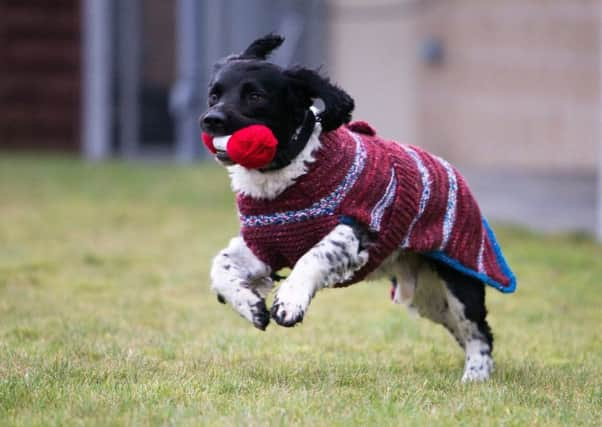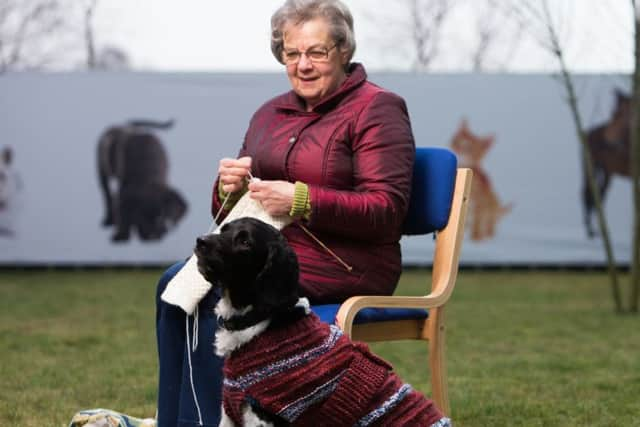Scots WI's step in to help colour-discriminated dogs


The SWI aim to help the pooches find their forever homes by creating colourful woollen overcoats.
Black Dog Syndrome results in dark-coated dogs being overlooked by potential new owners in favour of those that are lighter-coloured.
Advertisement
Hide AdIt means that dogs with black or dark fur tend to remain in the care of The Scottish Society for the Prevention of Cruelty to Animals (Scottish SPCA) for longer periods of time.


After learning about the discrimination being faced by the homeless hounds, SWI approached fellow charity the Scottish SPCA offering their members’ services to knit ‘coats of many colours.’
It is hoped the technicoloured coats – created as part of the celebrations to mark 100 years of the SWI – will make dark-coloured dogs more attractive to potential re-homers.
SWI national chairman Christine Hutton said: “We are encouraging our members to pick up their knitting needles and help a homeless hound.


“It’s a mission to help end Black Dog Syndrome, a phenomenon whereby potential new owners overlook black dogs in favour of their lighter-coated counterparts. “Some of Scotland’s top craftswomen are making multi-coloured dog coats in aid of homeless pets desperately seeking loving new homes – to boost their appeal and help them become rehomed more quickly.
“It’s sad to think of black dogs being less appealing simply because of the colour of their coat, but we hope that our knitters will be able to kit them out in coats of many colours and improve the chances of them being rehomed more quickly.”
Advertisement
Hide AdDark animals tend not to photograph well and it can be difficult to distinguish their features.
“If they have any white or grey hairs, these show up against their black coats and may make them look older than they are. Their teeth also look comparatively whiter and this can make black dogs appear more threatening than those with lighter coats.
Superstition has given black dogs bad image too.
Advertisement
Hide AdIn British folklore, black dogs often appear as evil forces that represent death to those who see them.
Writers Sir Walter Scott and Arthur Conan Doyle played up these superstitions using spectral hounds in their stories and poems. In more recent years, Hagrid’s dog Fang in the Harry Potter books and films – a very docile and loving creature - was a big black hound. It is thought that sometimes these stories pass into people’s beliefs subconsciously.
The first knitted dog jackets were created by Edith Smith and Winnie Anderson, members of SWI groups in the Aberdeenshire Federation, and were donated to the Scottish SPCA rescue and rehoming centre at Drumoak, near Banchory.
Scottish SPCA Superintendent Sharon Comrie said: “This syndrome really does affect the adoption of animals in our care and, through no fault of their own, black dogs are almost always the last to find new homes.
“It’s a really creative idea to knit coloured jackets to show these dogs off to their best advantage.
“Knowing that the SWI has members in every part of Scotland, many of whom are extremely dextrous when it comes to traditional crafts, means that we’ll hopefully be able to help animals in the nine rescue and rehoming centres we operate in Scotland.
Advertisement
Hide Ad“Knitted jackets will be ideal because they will be soft on the skin, have an element of give and stretch, and can be created in any, or many, colours of wool.
“Every knitted jacket that we receive will be put to good use at our rehoming centres across Scotland and with the SWI knitters’ support, we will be able to build up a collection of special jackets for our dark dogs to wear with pride.”
Advertisement
Hide AdAs one of the largest women’s member organisations in Scotland, the SWI is pleased that its members’ talents have been recognised by the Scottish SPCA and is encouraging its members to get involved.
“The appeal to knit dog jackets comes as the SWI, currently celebrating its centenary, has put a focus on preserving and promoting traditional handicrafts like knitting, embroidery and sewing.”
Christine added: “Our members love a challenge and this will support the efforts of the Scottish SPCA which does a fantastic job in promoting animal welfare and strives to end animal cruelty across the nation.
“We hope, in our own special way, that the SWI can play a small part in its efforts to match rescued animals with new owners.”
For more details of how to find your nearest Institute and learn or develop skills and make friends, visit www.theswi.org.uk or go to its Facebook page at https://www.facebook.com/ScottishWomensInstitutes
The Scottish Women’s Institutes (SWI) is one of the largest educational organisations for women in Scotland, with 716 branches spread across 32 Federation areas. The SWI is celebrating its centenary throughout 2017, with a range of events and gatherings to mark the SWI milestone including an exhibition in Edinburgh from 5-18 April open to the public and reflecting the changing times of the organisation and society through feature artefacts, handcrafts and archive materials including vintage kitchenalia, handmade baby clothing, rural chinaware and rarely seen archive materials.
Advertisement
Hide AdAlso planned is a ceremonial tree planting and tea parties which will take place in each of the 32 Federation areas at venues including village halls, a race course and a castle.
The organisation gives women of all ages the opportunity to learn new skills, build on existing ones and make new friends. Every Federation works to enhance local community life and constantly strives to preserve the quality of Scottish living.
Advertisement
Hide AdThe SWI was formed in 1917 as the Scottish Women’s Rural Institutes with two main aims, to advance the education and training of those who live and work in the country, or are interested in country life, in home skills, family welfare and citizenship and to promote the preservation of Scotland’s traditions and its rural heritage.